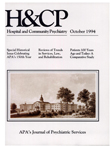Trends in the Development of Psychiatric Services, 1844-1994
Abstract
Over the past 150 years, support for providing appropriate services for mentally ill persons has waxed and waned. in colonial America, mentally ill persons were institutionalized in jails or almshouses. in the 18th and 19th centuries, asylums constituted the primary psychiatric service. Only in the late 19th and early 20th centuries did alternatives to long-term hospitalization appear. The mental hygiene movement of the early 20th century and the community mental health centers movement of the 1960s and 1970s both increased the number of services and introduced new types of services. Today, however, despite hopeful signs of reduced public prejudice against mentally ill persons, a new "dark age" for support of psychiatric services may be dawning, as negative attitudes about mental illness continue to drive public policy.
Access content
To read the fulltext, please use one of the options below to sign in or purchase access.- Personal login
- Institutional Login
- Sign in via OpenAthens
- Register for access
-
Please login/register if you wish to pair your device and check access availability.
Not a subscriber?
PsychiatryOnline subscription options offer access to the DSM-5 library, books, journals, CME, and patient resources. This all-in-one virtual library provides psychiatrists and mental health professionals with key resources for diagnosis, treatment, research, and professional development.
Need more help? PsychiatryOnline Customer Service may be reached by emailing [email protected] or by calling 800-368-5777 (in the U.S.) or 703-907-7322 (outside the U.S.).



